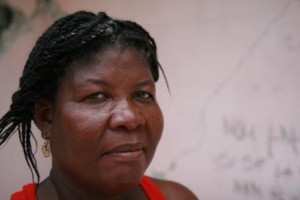With the rain come restless nights in Haiti

The rainy season has started in Haiti—the time many have dreaded for the extra misery it will bring to people who lost their homes in the January 12 earthquake. Plastic sheets strung overhead are all that many of them have for protection, making rainy nights long and exhausting. That’s why the coping strategy of Marie Carole Bourslquot is so remarkable. She’s one of the small vendors Oxfam’s partner has hired to cook food for the most vulnerable people in her neighborhood, and she shares a shelter with her mother, two sisters, a brother, and three of his children.
“We stay awake and tell jokes,” said Bourslquot.
“We lost a brother in the earthquake and since then our mother has been very down. We’ve been trying to encourage her….When we told her a joke, she started to smile so now we tell her jokes to make her laugh. We want her to smile again.”
But the energy Bourslquot and her siblings pour into easing their mother’s sorrow can’t alter this simple fact of their life during the last three months: “This area where we live is now very bad. It’s not fit for humans to live,” said Bourlsquot, adding they cobbled together a shelter of metal sheets. With the rain drumming hard around them and seeping into their shelter, family members have no choice but to stay awake, standing on their feet during the downpours which have been coming every night recently.
For countless families struggling to put their lives back together, the rain only makes things worse: Rose Guerline Dorvilus points to the channel etched by rain that drips through the roof and onto the floor where some of her family sleeps; Maxime Augustine describes restless nights moving the plastic on his shelter this way and that way to stop the leaks.
Aid groups have already reached more than a million people with emergency shelter materials. They have been favoring the distribution of tarps over tents in part because the large plastic sheets are more versatile: they can be used as tents or draped over existing homes as waterproofing, helping people inside stay dry.
With homeless families returning to the city, the ranks of those needing shelter have swollen. Oxfam is urging the government and the UN to consult with people and make sure everyone has access to information about their shelter options—including the possibility of moving back into their own homes. We’re also supporting engineering assessments on buildings so that people will know if their damaged homes are safe for living in.
And looking ahead, Oxfam is exploring ways to provide people with transitional housing. Together with the School of Architecture at the University of Queskaya/Port-au-Prince, we’ve agreed to collaborate on a student design competition. A committee of Haitians and international experts will pick the top three designs for multi-family transitional shelter, with possible construction of prototypes beginning in July.
But for now, there is another reality on the horizon adding to the worry and exhaustion many people continue to endure under the roofs of their temporary shelters: Hurricane season starts in June. The potential for high winds, walls of rain, and mudslides on the steep hills around Port-au-Prince is just one more burden for a population that has known no respite from hardship.
What are the jokes that Bourslquot tells in the midst of all this? Maybe they’re private, maybe they’re flashes of family hilarity. But their power is in what they produce: the warmth of a mother’s smile—a deep comfort when a makeshift shelter offers so little.